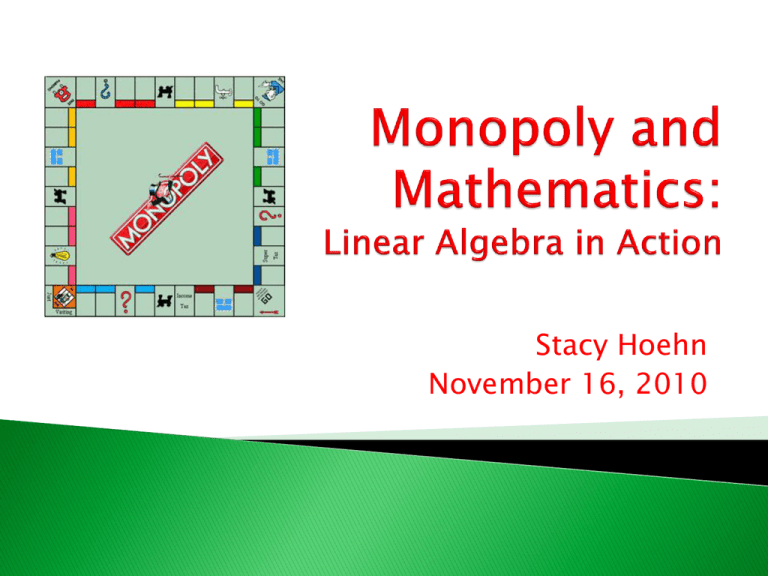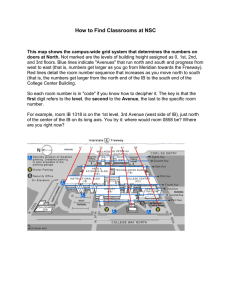Monopoly and Mathematics: Linear Algebra in Action
advertisement

Stacy Hoehn November 16, 2010 Games and Mathematics •Probability: Casino games like blackjack •Probability and Linear Algebra: Many board games in which movement along a track of spaces is completely determined by dice, spinners, and/or cards. •For these types of games, linear algebra can help us determine which squares on the game board tend to be occupied the most often, which, in turn, can help us develop strategies that take advantage of this information. •In Monopoly, players buy, sell, rent, and trade real estate in a competition to bankrupt their opponents. •They take turns rolling a pair of dice, with the totals indicating how many spaces to proceed along an outside track that includes •22 Properties •4 Railroads •2 Utility Companies •3 Chance Squares •3 Community Chest Squares • 6 Miscellaneous squares labeled Go, Income Tax, Just Visiting/Jail, Free Parking, Go to Jail, and Luxury Tax. •Players start at Go. If doubles are rolled, you get another roll. Rolling 3 consecutive doubles sends a player directly to the "In Jail" square. • To get out of jail, the player must throw doubles, pay a fine of $50, or use a get-out-of-jail-free card. What squares would we expect to visit most often? Simulation A Simpler Example •Start on the board location marked ‘1’. •Flip a coin: •Heads – move one space clockwise •Tails – move two spaces clockwise Probability of being on each of the board locations after n turns Location n=O n=1 n=2 n=3 n=10 n=15 n=25 1 1 0 0.25 0.375 0.2500 0.2480 0.2499 2 0 0.5 0 0.375 0.2344 0.2480 0.2501 3 0 0.5 0.25 0.125 0.2500 0.2520 0.2501 4 0 0 0.5 0.125 0.2656 0.2520 0.2499 It appears that as n grows larger, the probability of being on any of the locations at the end of turn n is approaching 0.25. Is this the case? Translating into Linear Algebra • Let xn be the vector whose • 1st entry is the probability of being in location ‘1’ after n turns • 2nd entry is the probability of being in location ‘2’ after n turns • 3rd entry is the probability of being in location ‘3’ after n turns • 4th entry is the probability of being in location ‘4’ after n turns 1 0 0.25 0 0 . 5 0 x0 , x1 , x2 Examples: 0 0.5 0.25 0 0 0.5 • Let A be the matrix whose entry in row i, column j is the probability of moving from location j to location i when flipping a coin. 0 0.5 0 0 0.5 0 A 0.5 0.5 0 0 0.5 0.5 • Note that x1 = Ax0, x2 = Ax1, and, in 0.5 0.5 0 0 general, xn+1 = Axn. Markov Chains •A probability vector is a vector with nonnegative entries that add up to 1. •A stochastic matrix is a square matrix whose columns are all probability vectors. •A Markov chain is a sequence x0, x1, x2, … of probability vectors, along with a stochastic matrix A so that x1 = Ax0 , x2 = Ax1 , and, in general, xn+1 = Axn . •If the probability vectors x0, x1, x2, … that make up a Markov chain converge to a vector x, then x is called a steady-state vector for the Markov chain. •The steady-state vector for a Markov chain tells us the longterm behavior of the process. •The steady-state vector for a Markov chain is a probability vector x so that Ax =x. Back to Our First Game 0.25 0 . 25 . •For our first game, the steady state vector is x 0.25 0.25 •This means that in the long run, we would expect to be on any of the squares with equal probability. Our Next Game: • Start on the location labeled ‘1’. • Flip a coin. Move 1 space clockwise if you get heads, and move 2 spaces clockwise if you get tails. • If you land on Space 3, slide directly back to Space 2. 0 0.5 0.5 Transition Matrix: A 1 0.5 0.5 0 0 0 •Probability of being on each of the board locations after n turns Location n=O n=1 n=2 n=3 n=5 n=10 1 1 0 0.5 0.25 0.3125 0.33398 2 0 1 0.5 0.75 0.6875 0.66602 3 0 0 0 0 0 0 Steady-state vector: 1 3 x 2 . 3 0 In the long-run, you would expect to be on Space 2 two-thirds of the time! Chutes and Ladders Rules: • Start with your playing piece to the left of Square 1. • Spin the spinner and move accordingly. • If you land on a square which contains the bottom of a ladder, move to the square at the top of the ladder. • If you land on a square which contains the top of a chute, move to the square at the bottom of the chute. • The game ends when you (or one of your opponents) reach Square 100 with an exact spin of the spinner. Chutes and Ladders (cont’d) •The transition matrix for Chutes and Ladders has 101 rows and 101 columns! • The first column (which corresponds to the starting position) has •1/6 in the rows corresponding to squares 2, 3, 5, 6, 14, and 38 • 0’s elsewhere. • The column which corresponds to square 99 has •5/6 in the row corresponding to square 99 •1/6 in the row corresponding to square 100 • 0’s elsewhere. •After two turns, the probability of being in the various squares is: •1/36 for Squares 3, 12, 15, 17, 18, 19, 20, 39, 40, 41, 42, 43, 44 •2/36 for Squares 5, 10, 11, 14 •3/36 for Square 31 •4/36 for Squares 6, 7,8 •0 for all other squares 0 0 •The steady-state vector for this game is x , as we might expect. 1 Monopoly as a Markov Process: Necessary Assumptions: •After picking up a Community Chest or Chance card, you perform the indicated action and then shuffle the card back into the correct stack instead of just putting it on the bottom of the stack. •Get-Out-of-Jail-Free cards are not used; they are simply shuffled back into the deck if picked. • Jail Options: • Always leave jail on the first turn. • **Remain in jail as long as possible (until third turn or you roll doubles). Steps to create Monopoly’s transition matrix: 1. Make a matrix with 40 rows and 40 columns which simply models where you can move by rolling the dice once, ignoring the special rules if you roll doubles. 2. Modify the matrix to include 3 special rows/columns for jail: jail—1st turn, jail—2nd turn, and jail—3rd turn. 3. Make changes to account for the fact that the Go-to-Jail square acts like a slide to the jail (1st turn) square. 4. Make changes to account for the Chance cards. 5. Make changes to account for the Community Chest cards. 6. Take into account the special rule about going to jail if you roll doubles 3 times. This will require adding 80 rows/columns to your matrix! The Steady-State Vector for Monopoly: Rank 1 2 3 4 5 6 7 8 9 10 11 12 13 14 15 16 17 18 19 20 21 Long-Term Property Name Probability Jail 9.39% Illinois Avenue 3.00% GO 2.92% B&O Railroad 2.89% Free Parking 2.82% Tennessee Avenue 2.82% New York Avenue 2.81% Reading Railroad 2.81% St. James Place 2.68% Water Works 2.65% Pennsylvania Railroad 2.64% Electric Company 2.62% Kentucky Avenue 2.61% Indiana Avenue 2.57% St. Charles Place 2.56% Atlantic Avenue 2.54% Pacific Avenue 2.52% Ventnor Avenue 2.52% Boardwalk 2.49% North Carolina Avenue 2.48% Marvin Gardens 2.44% Rank 22 23 24 25 26 27 28 29 30 31 32 33 34 35 36 37 38 39 40 41 Long-Term Property Name Probability Virginia Avenue 2.43% Pennsylvania Railroad 2.36% Community Chest 2 2.30% Short Line 2.29% Community Chest 3 2.23% Income Tax 2.20% Vermont Avenue 2.19% States Avenue 2.18% Connecticut Avenue 2.17% Just Visiting 2.14% Oriental Avenue 2.13% Park Place 2.06% Luxury Tax 2.06% Baltic Avenue 2.04% Mediterranean Avenue 2.01% Community Chest 1 1.78% Chance 2 1.04% Chance 3 0.82% Chance 1 0.82% Go to Jail 0.00% Expected Revenues Color Group Expected Revenue per Expected Number Opponent Roll (with of Opponent Rolls Hotels) Total Cost to Break Even Dark Purple $14.20 $620.00 44 Light Blue $36.81 $1,070.00 30 Magenta $57.34 $1,940.00 34 Orange $80.35 $2,060.00 26 Red $87.36 $2,930.00 34 Yellow $87.45 $3,050.00 35 Green $96.78 $3,920.00 41 Dark Blue $80.65 $2,750.00 35 Which is better? Expected Revenue after n Opponent Rolls Color Group n=30 n=50 n=100 ($193.88) $90.20 $800.40 $2,220.79 Light Blue $34.43 $770.71 $2,611.42 $6,292.84 Magenta ($219.68) $927.19 $3,794.38 $9,528.77 $350.57 $1,957.61 $5,975.22 $14,010.44 Red ($309.33) $1,437.79 $5,805.58 $14,541.17 Yellow ($426.62) $1,322.31 $5,694.61 $14,439.23 Green ($1,016.60) $918.99 $5,757.99 $15,435.98 ($330.60) $1,282.33 $5,314.66 $13,379.31 Dark Purple Orange Dark Blue n=200 Conclusions • Jail is the most frequently visited square, followed by Illinois Avenue. • Squares that are reachable from Jail or Chance/Community Chest Cards are more likely to be visited than other squares. • Park Place, which is one of the traditionally coveted dark blue properties, is visited approximately 45% less often than Illinois Avenue. • The orange property group, when fully developed, has the lowest expected break-even point of any of the properties. (Important for short games!) • The green properties, when fully developed, have the highest expected revenue per turn. (Important for long games!) •The dark purple properties are hardly worth buying due to the low frequency in which they are visited and their high expected break-even point.


